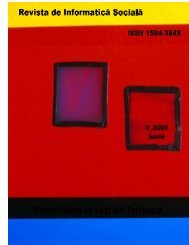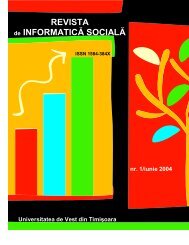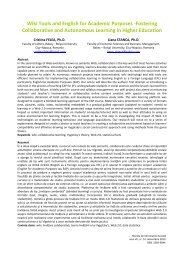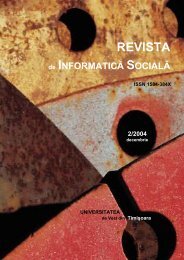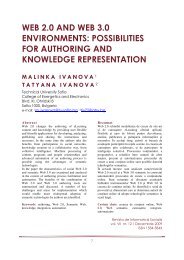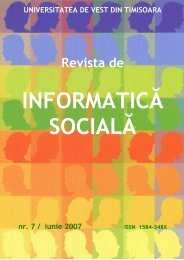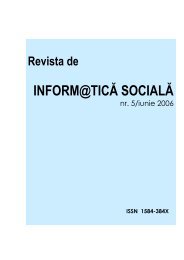No 13 - Journal of Social Informatics / Revista de Informatica Sociala
No 13 - Journal of Social Informatics / Revista de Informatica Sociala
No 13 - Journal of Social Informatics / Revista de Informatica Sociala
You also want an ePaper? Increase the reach of your titles
YUMPU automatically turns print PDFs into web optimized ePapers that Google loves.
also as generators <strong>of</strong> signals that can be used for exerting power and influence by directing the<br />
user's attention.<br />
For instance: when the number <strong>of</strong> Internet tra<strong>de</strong>rs or Blog writers rises to the millions, it<br />
becomes ever less attractive to be just one <strong>of</strong> them, but ever more attractive to become a gui<strong>de</strong> able<br />
to inform many others that a specific useful website or web <strong>of</strong>fer exists and to persua<strong>de</strong> them to<br />
make a visit.<br />
In conventional media systems, power by directing attention is usually highly centralized:<br />
accruing to potent advertizers who market their products or to major newspapers or TV stations able<br />
to influence politics by "agenda setting" (= by <strong>de</strong>termining about the issues that should (or should<br />
not) be the topic <strong>of</strong> public <strong>de</strong>liberation. In the Internet, such guidance functions seem to become<br />
<strong>de</strong>centralized in the same way as the production or primary contents. A case in point is "Twitter"<br />
where potentially everybody can usurp the status <strong>of</strong> an opinion lea<strong>de</strong>r by collecting a large number<br />
<strong>of</strong> followers whose "eyeballs" can be directed to any topic, information source or web address at his<br />
(or her) personal will.<br />
In other words: the rise <strong>of</strong> Twitter illustrates the <strong>de</strong>mocratization <strong>of</strong> "push advertizing" (and<br />
propaganda) that is a logical functional correlate <strong>of</strong> the <strong>de</strong>centralized WWW. It follows the radical<br />
<strong>de</strong>volution <strong>of</strong> "pull advertizements" (exemplified by Craigslist).<br />
8. THE NEED FOR SEMANTIC EMBEDMENT AND PRESPECIFICATIONS<br />
Given the shortness <strong>of</strong> single Twitter messages, it will <strong>of</strong>ten not be possible to assess its<br />
precise meaning, because author i<strong>de</strong>ntity, time, place and situational conditions <strong>of</strong> its origin are not<br />
explicated and the terms used not sufficiently <strong>de</strong>fined. In particular, there is no space for<br />
accompagning the message with metacommunicative specifications (e. g. by relativizing an<br />
assertion, signaling irony, or by emphasizing the urgency <strong>of</strong> a plea).<br />
For knowing exactly what a single message means, it is necessary to relate it to already<br />
existing knowledge about the larger context in which it is embed<strong>de</strong>d:<br />
by consi<strong>de</strong>ring previous messages coming from the same source;<br />
by un<strong>de</strong>rstanding it as stemming from a person who shares the same culture as the receivers:<br />
<br />
their values, habits and all the meanings associated with verbal terms and expressions;<br />
by relating it to highly specific environmental conditions or problem <strong>de</strong>finitions currently<br />
shared by all communicators.<br />
These three sources <strong>of</strong> specification are substitutes. For instance, the less I know the sen<strong>de</strong>r<br />
<strong>of</strong> a tweet, the more I have to rely on his previous messages or on i<strong>de</strong>ntical environmental<br />
conditions. And the more all participants share a common environment, the better they will <strong>de</strong>co<strong>de</strong><br />
the meaning <strong>of</strong> their mutual messages correctly without any previous acquaintance and interaction.<br />
Therefore, optimum conditions for Twittering exist in situations where conventional<br />
institutions and media have already created a space <strong>of</strong> highly specific shared meanings, mutual<br />
un<strong>de</strong>rstandings and structured expectations: e. g. in U. S. presi<strong>de</strong>ntial elections where everybody<br />
waited for Obama to announce his candidate for vice presi<strong>de</strong>ncy by a Tweet, or at Obama’s<br />
Inauguration where Twitter served to accompany the TV broadcast with a wealth <strong>of</strong> spontaneous<br />
commentaries. This latter event has shown that in contrast to other Web services with larger<br />
bandwidth, Twitter runs without downtime even un<strong>de</strong>r very heavy loads <strong>of</strong> traffic (Franke-Ruta,<br />
2009).<br />
Similar conditions hold for mutually well acquainted members <strong>of</strong> stable teams are working<br />
within a highly stable environment where only well foreseeable, highly specific events,<br />
<strong>de</strong>velopments and problems arise. In such cases, even very short messages are well un<strong>de</strong>rstood<br />
because they are based on a highly "restricted co<strong>de</strong>" 4 <strong>of</strong> well-<strong>de</strong>fined consensual words and<br />
expressions.<br />
4 A term coined by Basil Bernstein 1964.<br />
pag. 15: <strong>Revista</strong> <strong>de</strong> Informatică <strong>Social</strong>ă | Vol. III (<strong>13</strong>) / 2010 | ISSN 1584-384X



